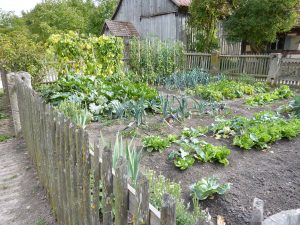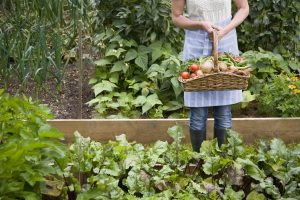After you have chosen and measured your garden area, spread out a large sheet of paper—shelf paper will do. Use a simple scale, such as one inch for one foot. Draw lines every 3 inches across the paper to represent walkways 3 feet apart in the plot. Picture the space between the walkways as slightly raised beds. Down each of these beds you can run two rows of small-to-medium sized vegetables or one row of larger types. Extra-large vegetables, such as melons and squash, must be given two or three full beds to sprawl across. Seed packets give you some clues by listing heights and recommended spacing between plants, but also consider the points that follow.
1.Visualize mature height and spread
Such perennials as rhubarb and asparagus grow very tall and can be harvested for only a relatively short time.
They should be placed in the back of your garden so that they’re out of the way after harvest. Plant tall vegetables on the north side of the garden and shorter ones on the south side. Sweet corn, pole varieties of beans and peas, and tomatoes are all tall-growing vegetables.

Bush squash and eggplant can reach two and a half feet in height. Place them in the middle of the garden. Most other vegetables—bush beans, beets, carrots, and turnips, for example—grow no more than 14 to 18 inches high and equally wide.
Don’t be misled by the descriptive term “bush” when it’s applied to summer squash, eggplant, and okra. Bush varieties are more compact than the runner types, but even they can grow 30 inches high and 4 feet wide. Another misnomer is “dwarf” okra; in rich soil this plant can grow nearly 6 feet tall by the end of summer. Double-check the mature size of dwarf and miniature vegetables in the seed catalog or on the packet before you buy.
The size of some mature plants, such as Brussels sprouts, cauliflower, and cabbage, is not the same as the size of the heads at produce counters. Outer leaves on late-maturing cabbage, for example, can cover a 24 to 30-inch span. Cauliflower, Brussels sprouts, and broccoli can grow to 24 inches high and equally as wide. Kale and collards don’t form heads like cabbage; instead, they develop tall, upright plants.
2.Think short rows
Divide each row into short segments, about 4 feet in length. This will keep you from planting too much of any one vegetable at a time. Plant long rows of vegetables only if you intend to can or freeze them or if they are a type you can leave on the plants for a vvhile after they mature. Vegetables that can be stored on plants include winter squash, potatoes, turnips, rutabagas, onions, and beans grown for dry seeds.
3.Interplant to save space

Interplanting lets you harvest more vegetables from a small garden. Instead of planting individual rows of quick-maturing vegetables (leaf lettuce, radish, curly cress, onion sets, spinach, turnips, and mustard greens), scatter a few of these seeds among young plants of larger or slower-maturing vegetables, such as sweet corn, peppers, tomatoes, and eggplant. Some gardeners never plant separate rows of radishes; they just plant radish seeds among the slow sprouters, such as parsley and carrots. The radishes are eaten before the parsley and carrots are more than an inch or so high.
You can use the same space to grow two or three crops in succession in a single season. Combined with inter- planting, succession cropping can help you harvest more from a given area. When you take out an early crop. plant another one as soon as you can work amendments into the soil.
Here’s a typical sequence of succession planting: plant peas or spinach in very early spring. As soon as these crops are out of the ground, rework the bed and plant warmth-loving vegetables, such as beans. In mildwiriter climates you can pull up ‘the beans and plant carrots, radishes, turnips, lettuce, or cole crops for fall and winter harvests.
 Burke Knows Words A vision for your life
Burke Knows Words A vision for your life